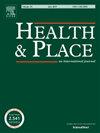Association of housing precariousness with depressive symptoms and suicidal ideation: Findings from a nationwide survey of young adults in South Korea
IF 4.1
2区 医学
Q1 PUBLIC, ENVIRONMENTAL & OCCUPATIONAL HEALTH
引用次数: 0
Abstract
Adequate housing quality is fundamental to wellbeing. This study examined the associations between housing precariousness (HP), depressive symptoms, and suicidal ideation among young adults. A nationally representative sample of 14,800 Korean adults aged 19–34 years was analyzed. HP was measured across five dimensions: housing affordability, housing tenure, housing satisfaction, neighborhood quality, and community cohesion. An overall HP score (ranging from 0 to 10) was categorized into four levels: lowest, low, high, and highest. Depressive symptoms were determined based on the Patient Health Questionnaire-9, and suicidal ideation in the past year was evaluated. Logistic regression models calculated odds ratios (ORs) and 95 % confidence intervals (CIs). Among participants, 5.8 % reported depressive symptoms, and 2.4 % reported suicidal ideation. Compared with individuals with the lowest HP levels, individuals with high HP levels (OR: 1.45; 95 % CI: 1.07–1.96) and the highest HP level (OR: 3.22; 95 % CI: 2.37–4.37) were more likely to experience depressive symptoms. Similarly, the odds of suicidal ideation were higher among those with the highest HP level (OR: 3.38; 95 % CI: 2.21–5.19). Each 1-point increase in the HP score was associated with a 1.44-fold increase in the odds of experiencing depressive symptoms (95 % CI: 1.34–1.55) and a 1.46-fold increase in the odds of reporting suicidal ideation (95 % CI: 1.31–1.62). HP is associated with both depressive symptoms and suicidal ideation among young adults in South Korea. Therefore, multifaceted policy efforts are required to enhance housing quality of young adults.
住房不稳定与抑郁症状和自杀意念的关系:韩国一项针对年轻人的全国性调查的结果
适当的住房质量是幸福的基础。本研究探讨了年轻人住房不稳定性(HP)、抑郁症状和自杀意念之间的关系。对全国代表性的1.48万名年龄在19-34岁的韩国成年人进行了分析。HP是通过五个维度来衡量的:住房负担能力、住房使用权、住房满意度、社区质量和社区凝聚力。总体HP得分(从0到10)分为四个等级:最低、低、高和最高。根据患者健康问卷-9确定抑郁症状,并评估过去一年的自杀意念。Logistic回归模型计算比值比(ORs)和95%置信区间(ci)。在参与者中,5.8%报告有抑郁症状,2.4%报告有自杀念头。与HP水平最低的个体相比,HP水平高的个体(OR: 1.45;95% CI: 1.07-1.96)和最高HP水平(OR: 3.22;95% CI: 2.37-4.37)更容易出现抑郁症状。同样,HP水平最高的人产生自杀意念的几率也更高(OR: 3.38;95% ci: 2.21-5.19)。HP得分每增加1分,出现抑郁症状的几率增加1.44倍(95% CI: 1.34-1.55),报告有自杀念头的几率增加1.46倍(95% CI: 1.31-1.62)。HP与韩国年轻人的抑郁症状和自杀意念有关。因此,提高青年住房质量需要多方面的政策努力。
本文章由计算机程序翻译,如有差异,请以英文原文为准。
求助全文
约1分钟内获得全文
求助全文
来源期刊

Health & Place
PUBLIC, ENVIRONMENTAL & OCCUPATIONAL HEALTH-
CiteScore
7.70
自引率
6.20%
发文量
176
审稿时长
29 days
期刊介绍:
he journal is an interdisciplinary journal dedicated to the study of all aspects of health and health care in which place or location matters.
 求助内容:
求助内容: 应助结果提醒方式:
应助结果提醒方式:


